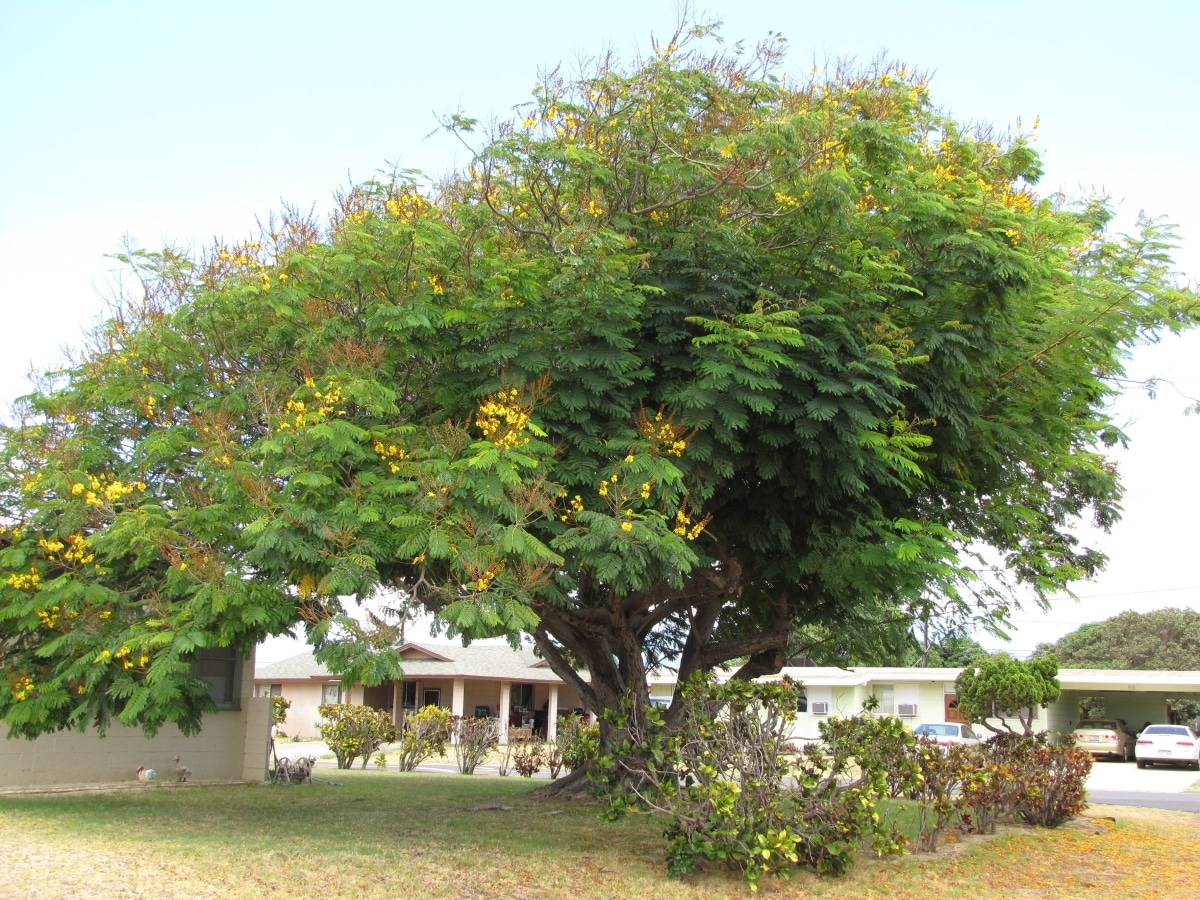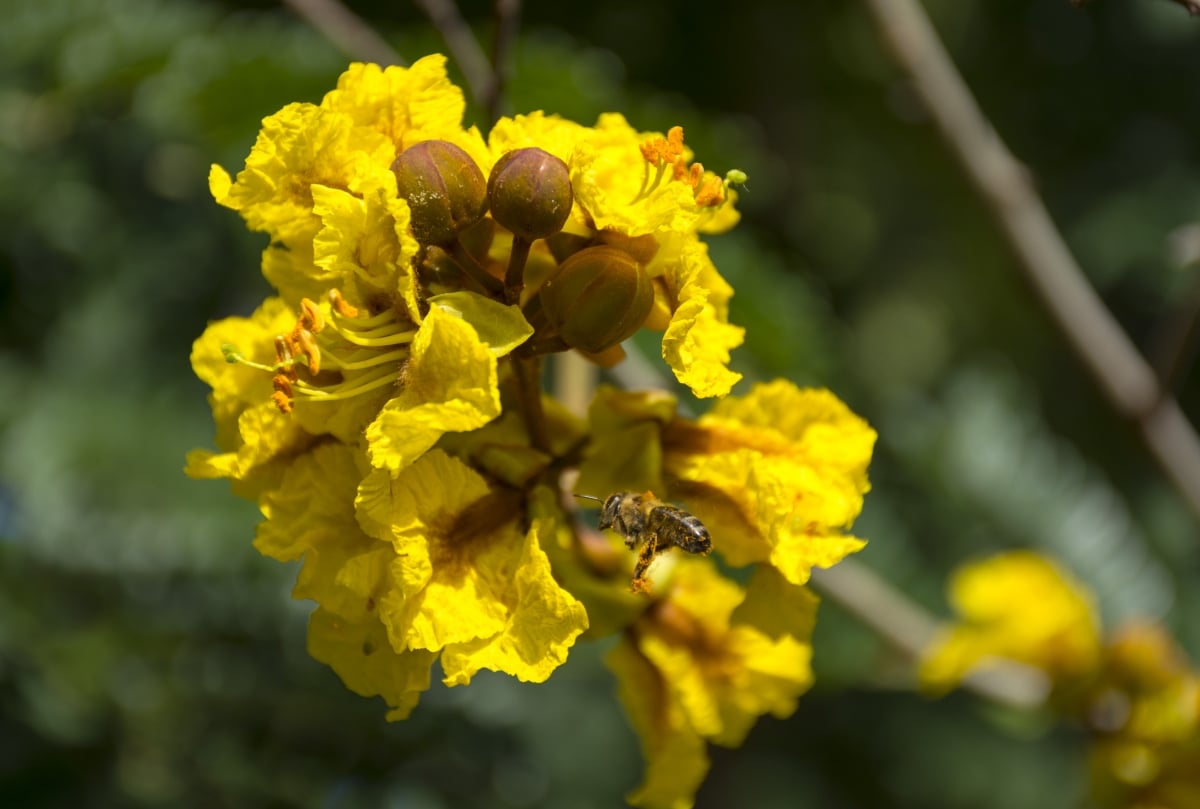
Image - Flickr / Dinesh Valke
You may have seen images of the red flamboyant tree, but what would you say if I told you that there is a tree that looks very similar but produces yellow flowers? It is so similar, that in fact it is known as yellow flamboyant. And yes, they belong to the same botanical family, but they do not originate from the same place.
Our protagonist is a tree that can become very large if the climate is warm throughout the year and it does not lack water. Also, it provides a lot of shade, so it is interesting to plant it in a garden.
Origin and characteristics of the yellow flamboyant

Image - Wikimedia / Forest & Kim Starr
It is a deciduous tree native to tropical southeast Asia and Australia whose scientific name is Peltophorum pterocarpum. It grows to a maximum height of 25 meters, with a trunk up to 1 meter in diameter and a crown 4-6 meters wide.. Its leaves are bipinnate, reaching between 30 and 50 centimeters long, and are composed of 20 to 40 leaflets or pinnae 1-2 centimeters long.
Its flowers are yellow and are grouped in clusters about 20 centimeters long.. The fruits are legumes about 10 centimeters long by 2 centimeters wide, which are first red and later black. Each of them contains approximately four seeds.
What uses does it have?
The yellow flamboyant is a very beautiful tree, which provides plenty of shade and that, in addition, it does not require much care when the weather is hot. For this reason, it is used as an ornamental plant, either as an isolated specimen planted near other trees, such as the true flamboyant.
Likewise, can be worked as bonsai, since it tolerates pruning. But yes, it is possible that, as happens to the Delonix direction, it is difficult for it to flourish.
Another use for it is as forage, that is, as food for animals such as cattle.
How do you take care of the yellow flamboyant?

Image – Wikimedia/Ivan2010
It is a fast-growing tree that can give us a lot of joy when the weather conditions are favourable; however, it is difficult to grow when grown in an area where winters are cold. So, before we talk about how to take care of it, let's see what it needs to grow well and comfortably:
- heat all year: temperatures should be kept between 15ºC and 35ºC.
- SOL: This is a must. Will not grow in shade.
- Water: from time to time, since it does not resist drought.
- Fertile land: rich in nutrients, and with good drainage, so you will not have problems.
And now yes, let's see what care we have to give it:
Location
It is a tree that must be in a sunny place, but also, and taking into account how big it can get, it should be planted as soon as possible in the ground and at a minimum distance of 4 meters from walls and trees they are big too.
As it is very sensitive to cold, if you have it in an area where there is frost, we recommend growing it in a pot so that, in this way, you have the option of bringing it indoors when the weather cools down. Of course, when the time comes, put it in a room where a lot of natural light enters, and keep it away from drafts.
Soil or substrate
The yellow flamboyant is a tree that should be planted in fertile, well-drained soils. In the event that it is going to be kept in a pot, it will be planted in one that has holes in its base with universal culture substrate such as this.
Irrigation
It is a tree that has to be watered from time to time, preventing the land from remaining dry for a long time. In fact, it is not unusual for it to be planted near ponds, since it also requires high ambient humidity so that its leaves do not dehydrate.
For this reason, if we live in an area where it does not rain much, we will have to water about 4 times a week during the summer, since it is when the land takes less time to dry, and once a week the rest of the year.
Subscriber
It is highly recommended to pay the yellow flamboyant while it is growing, that is, while temperatures remain high. For this, organic fertilizers will be used, such as manure or guano that you can buy here. Now, if it is in a pot, you have to use fertilizers or liquid fertilizers following the instructions on the package.
Multiplication

Image - Wikimedia / Vengolis
Do you want to have new copies? So you have to sow its seeds, either in spring (preferably) or in summer. The steps to follow are those:
- Fill a glass with a little water.
- Now, put the glass in the microwave for a few seconds, until the water is very hot. It should not boil, but it should be a bit uncomfortable for us to hold the glass after removing it from the appliance.
- The next step is to put the seeds in a small strainer, and place it in the water for 1 second.
- Then, we put the seeds in another glass full of water at room temperature, and leave them there for 24 hours.
- After that time, we will plant them in pots or in trays and forest seedbed with soil for seedbeds (for sale here), putting a maximum of two units in each container or alveolus.
- Finally, we will place the seedbed outside, in a sunny place.
If everything goes fine, we will see that they will germinate in the course of 1 to 2 months. But it is important that it is watered from time to time so that they do not dry out.
Pruning
You can prune it if necessary after flowering. Remove dry and broken branches, and don't hesitate to trim those that have grown more than necessary.
Rusticity
It is very sensitive to cold, so much so that it should not be grown in places where temperatures drop below zero degrees.
What did you think of the yellow flamboyant?